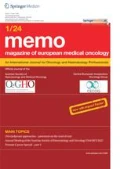Effective systemic therapy for advanced pseudomyxoma peritonei (PMP) is the focus of investigation. We describe a case of PMP arising from an adenoma of the appendix in a 58-year-old man. First, the patient underwent explorative laparotomy with ileocoecal resection, but without possibility of major tumour debulking due to adhesive gross tumour masses. Subsequently, six cycles of Folfox IV chemotherapy were administered, without response, but with severe side effects. Upon progressive disease, a combination of bevacizumab and capecitabine led to a long-term stabilization of disease and obvious improvement of performance status. Our case suggests that modulation of tumour microenvironment and angiogenesis by bevacizumab, potentially augmented by monochemotherapy, may be beneficial in borderline tumours such as pseudomyxoma peritonei.
References
Ronnett BM, Shmookler BM and Diener-West M et al (1997). Immunohistochemical evidence supporting the appendiceal origin of pseudomyxoma peritonei in women. Int J Gynecol Pathol 16: 1–9
Szych C, Staebler A and Connolly DC et al (1999). Molecular genetic evidence supporting the clonality and appendiceal origin of pseudomyxoma peritonei in women. Am J Pathol 154: 1849–1855
Ronnett BM, Yan H and Kurman RJ et al (2001). Patients with pseudomyxoma peritonei associated with disseminated peritoneal adenomucinosis have a significantly more favorable prognosis than patients with peritoneal mucinous carcinomatosis. Cancer 92: 85–91
Sugarbaker PH and Chang D (1999). Results of treatment of 385 patients with peritoneal surface spread of appendiceal malignancy. Ann Surg Oncol 6: 727–731
Smeenk RM, Verwaal VJ and Antonini N et al (2007). Survival analysis of pseudomyxoma peritonei patients treated by cytoreductive surgery and hyperthermic intraperitoneal chemotherapy. Ann Surg 245: 104–109
Hurwitz H, Fehrenbacher L and Novotny W et al (2004). Bevacizumab plus irinotecan, fluorouracil, and leucovorin for metastatic colorectal cancer. N Engl J Med 350: 2335–2342
Wedam SB, Low JA and Yang SX et al (2006). Antiangiogenic and antitumor effects of bevacizumab in patients with inflammatory and locally advanced breast cancer. J Clin Oncol 24: 769–777
Sandler A, Gray R and Perry MC et al (2006). Paclitaxel–carboplatin alone or with bevacizumab for non-small-cell lung cancer. N Engl J Med 355: 2542–2550
Escudier B, Pluzanska A and Koralewski P et al (2007). Bevacizumab plus interferon alfa-2a for treatment of metastatic renal cell carcinoma: a randomised, double-blind phase III trial. Lancet 370: 2103–2111
Prassl K, Sahanic A and Reicher B et al (2008). Striking response with bevacizumab and chemotherapy in a woman with heavily pretreated breast cancer: a case presentation. memo 1: 149–151
van Ruth S, Hart AA, and Bonfrer JM et al (2002). Prognostic value of baseline and serial carcinoembryonic antigen and carbohydrate antigen 19.9 measurements in patients with pseudomyxoma peritonei treated with cytoreduction and hyperthermic intraperitoneal chemotherapy. Ann Surg Oncol 9: 961–967
Miner TJ, Shia J and Jaques DP et al (2005). Long-term survival following treatment of pseudomyxoma peritonei: an analysis of surgical therapy. Ann Surg 241: 300–308
Byrne AT, Ross L and Holash J et al (2003). Vascular endothelial growth factor trap decreases tumor burden, inhibits ascites, and causes dramatic vascular remodeling in an ovarian cancer model. Clin Cancer Res 9: 5721–5728
Hu L, Hofmann J and Zaloudek C et al (2002). Vascular endothelial growth factor immunoneutralization plus paclitaxel markedly reduces tumor burden and ascites in athymic mouse model of ovarian cancer. Am J Pathol 161: 1917–1924
Burger RA, Sill MW and Monk BJ et al (2007). Phase II trial of Bevacizumab in persistent or recurrent epithelial ovarian cancer or primary peritoneal cancer: a Gynecologic Oncology Group study. J Clin Oncol 25: 5165–5171
Willett CG, Boucher Y and di Tomaso E et al (2004). Direct evidence that the VEGF-specific antibody bevacizumab has antivascular effects in human rectal cancer. Nat Med 10: 145–147
Inai T, Mancuso M and Hashizume H et al (2004). Inhibition of vascular endothelial growth factor (VEGF) signaling in cancer causes loss of endothelial fenestrations, regression of tumor vessels, and appearance of basement membrane ghosts. Am J Pathol 165: 35–52
Mancuso MR, Davis R and Norberg SM et al (2006). Rapid vascular regrowth in tumors after reversal of VEGF inhibition. J Clin Invest 116: 2610–2621
Garcia AA, Hirte H and Fleming G et al (2008). Phase II clinical trial of bevacizumab and low-dose metronomic oral cyclophosphamide in recurrent ovarian cancer: a trial of the California, Chicago, and Princess Margaret Hospital phase II consortia. J Clin Oncol 26: 76–82
Author information
Authors and Affiliations
Corresponding author
Rights and permissions
About this article
Cite this article
Sun, W.L., Hutarew, G., Gradl, J. et al. Bevacizumab-based combination therapy in a patient with pseudomyxoma peritonei. memo 2, 113–115 (2009). https://doi.org/10.1007/s12254-009-0113-y
Received:
Accepted:
Published:
Issue Date:
DOI: https://doi.org/10.1007/s12254-009-0113-y

